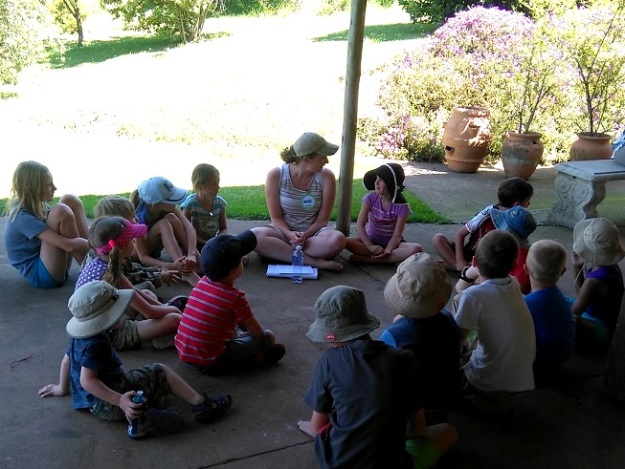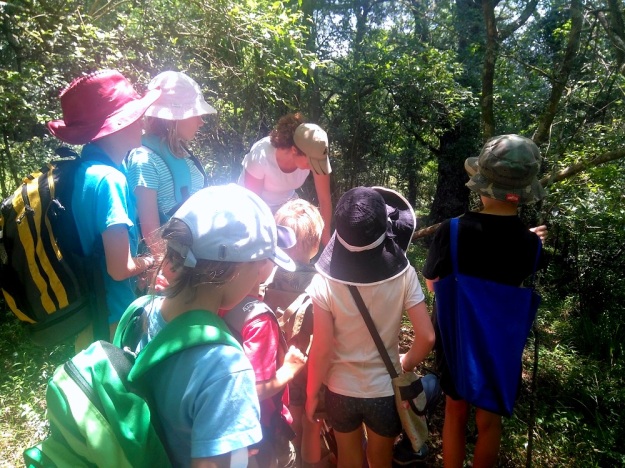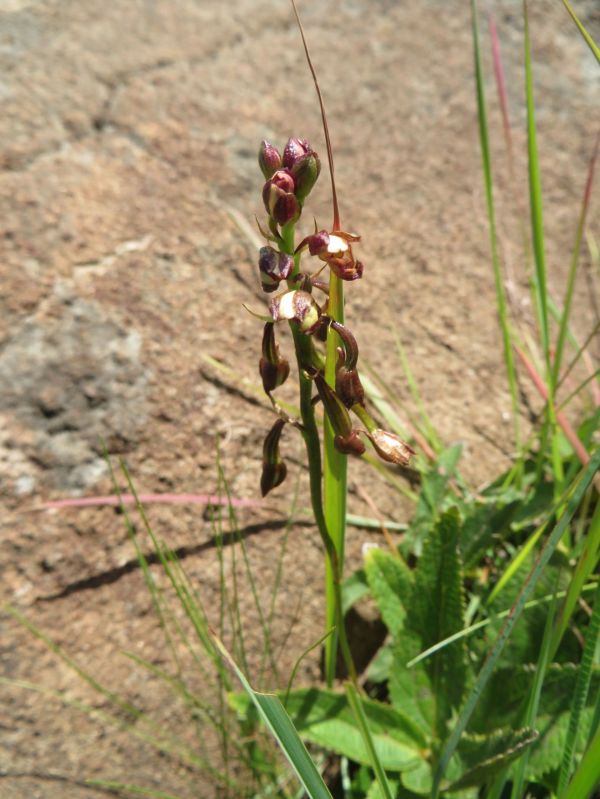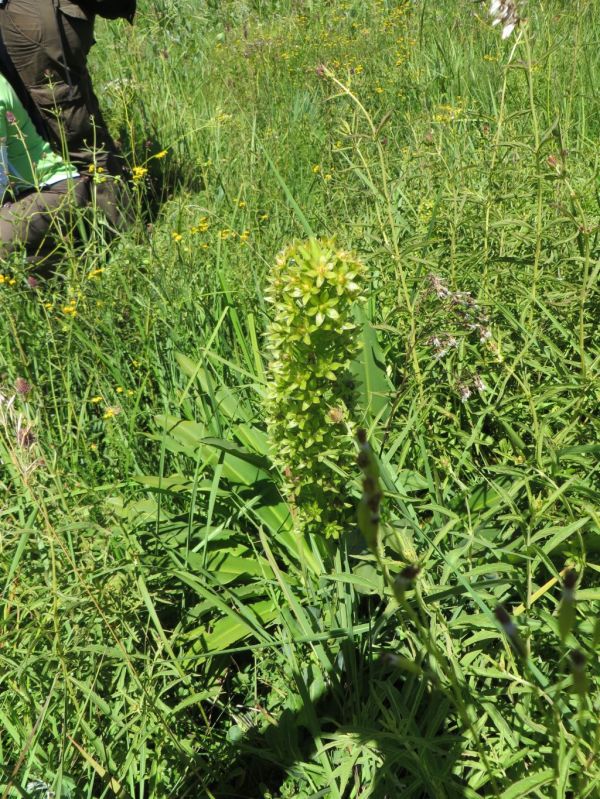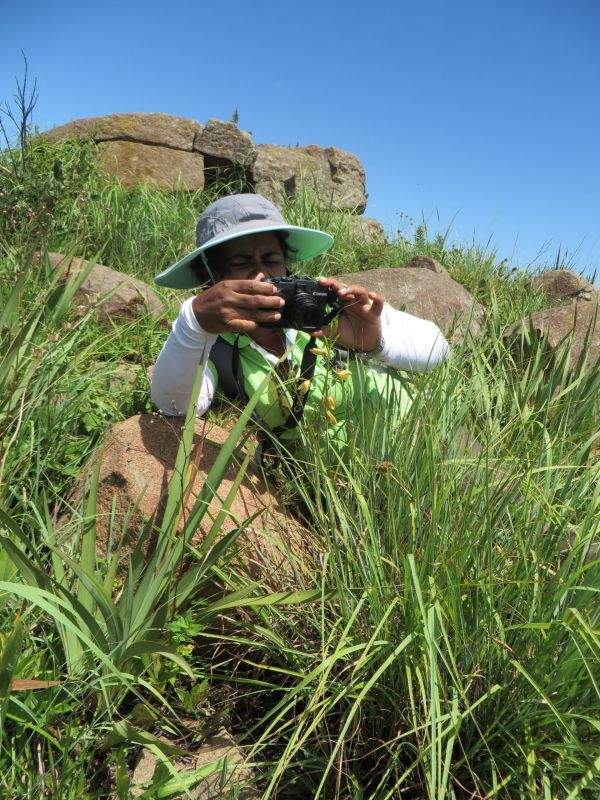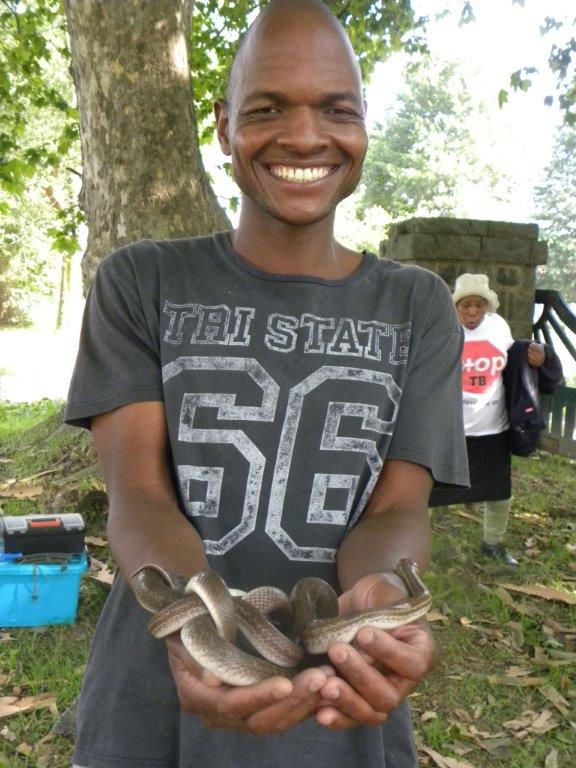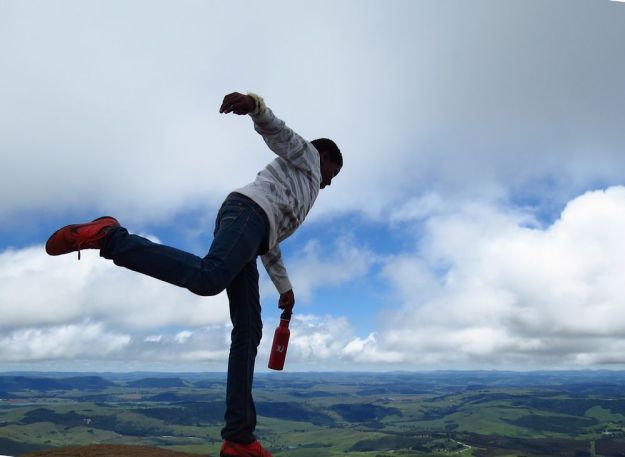Dodging potholes brimming with muddy water and splashing through the torrents rushing along farm tracks and over the road, we wondered at the wisdom of a mid-summer break in the ‘berg. However, as we emerged from the Kamberg Valley, gaps in the clouds revealed the Giant having an afternoon snooze, oblivious of the thunder. Yes, it is always worth simply heading out whatever the weather – one never knows what is actually in store. Besides, occasional glimpses of the mountains simply make them all the more mysterious.
Mtshezi
An early evening stroll along the banks of the Mtshezi (Bushman’s River) provided plenty of opportunity to chat about erosion, river valleys and smooth stones. As the rain stopped, hundreds of termites emerged from their underground haven into the calm evening, sitting on our arms and fluttering off across the river.

Later we found another mound that was in the process of being repaired. The new section clearly illustrating the ‘air-conditioning tunnels’ we had described earlier.

We had packed our miniSASS kit in the hope of overturning some rocks in the river and finding invertebrates that we have never come across in Mpophomeni streams. The Bushman’s River was flowing too strongly and we gave up. Bright Hesperantha coccinea was flowering on the river banks.

Some of us simply had to swim and soon got used to the cold water.

Others explored the river banks, rock hopped and took plenty of photos.

Some sat quietly simply absorbing the splendour.

After looking through the ID guides and books about Giant’s Castle and watching the mountains through the binoculars, we enjoyed supper on the veranda and a cosy evening beside the fireplace in the cottage at Snowflake.

Pouring over the map of the area after breakfast the next morning revealed two tarns located on the plateau we had planned to head towards that day. So we plotted our course – up the forested ravine then along the ridge towards the ‘Berg. Two black storks flew by as we set off.
Wildflowers & Waterfalls
The grass was long and wet, water was pouring off the hillside – delicious, cold and fresh.

Peak flowering season was over, but we did find many lovely specimens of Gladiolus crassifolius

Other memorable flowers included Eucomis autumnalis, Dicoma anomala, Gladiolus ecklonii, Crassula vaginata, Commelina Africana, Persicaria attenuate, Satyrium macrophyllym & cristatum, Habenaria lithophila. We saw lots of lovely beetles too.

Proteas are always a favourite when found on our trips to natural areas. This one was Protea roupelliae, one of five species found in KZN.

We found the tracks of buck and of jackal – both fresh – with the jackal definitely following the buck.

An antlion rested on the tip of tall grass.

We spotted a Cussonia paniculata (umsenge) in flower and on closer inspection discovered it was growing beside the stone wall of an old livestock enclosure. Clearly, previous inhabitants of the area had been pastoralists, although there were no cows anymore.

We came across really big specimens of Aloe maculata that everyone recognised from Mpophomeni – particularly because it is part of the Mpophomeni Conservation Group logo.

The sound of a waterfall enticed us to keep climbing. Nkulu and Bulelani could not resist standing beneath the icy water, clambering across huge boulders to get there.

Asanda was fascinated that the stream disappeared into the rocks before emerging as a waterfall and set about finding the route it took through the rocks – discovering it was just a small crevice that he could fit his arm into.

Tarns & Tadpoles
On top of the plateau, we all wandered off in different directions to find the tarns. Asanda particularly enjoyed the time alone, following the sound of birds that he thought might lead him to the water. “I really enjoyed this trip without lots of small children making noise.” he said quietly.
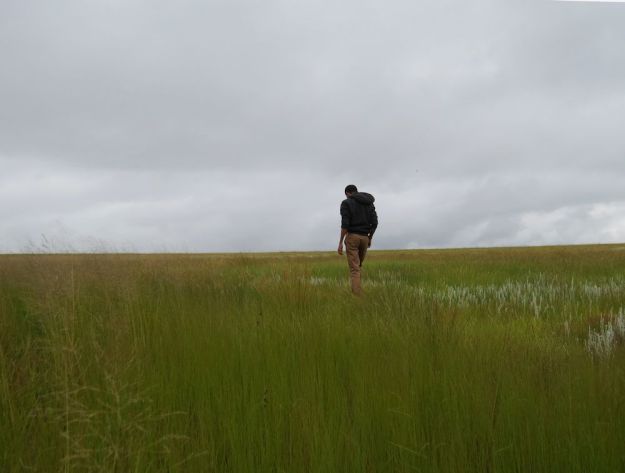
Christeen followed the frog sounds and found them eventually – not really what we had expected. The pools had been invaded by grass and it was more of a wetland now with just a few pools of water. It was really beautiful and unusual.

Along with the rest of South Africa celebrating Leap Day for Frogs, we had hoped to find a few of our own. With our eyes closed we identified four different calls, but all we found were lots and lots of dead tadpoles. We wondered if the water had been struck by lightning in the storm the day before. (Jeanne Tarrant of EWT suggested it might be the amphibian fungal disease – chytrid)
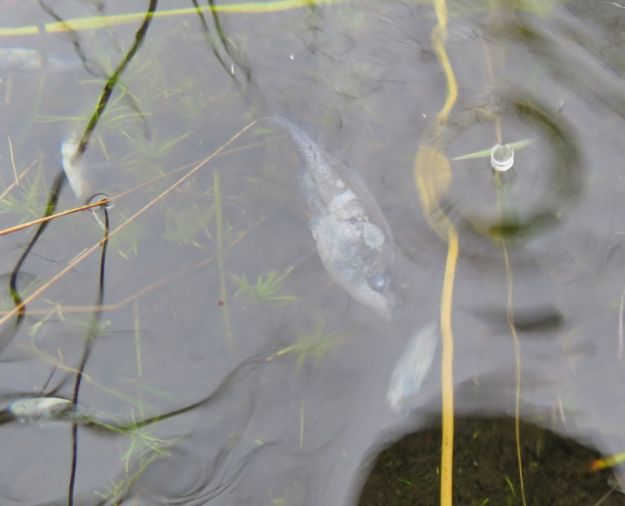
We spent some quiet time absorbing the peacefulness and incredible views.

Discussing ecology, religion, climate change and life, as we walked.

We had hoped to bump into an Eland, but only found an old bone.

We flushed a Marsh Owl on our way back through the grassland, characteristically it circled around us before heading off, giving us a wonderful opportunity to have a good look at it. Pretty damp, we were jolly pleased to head for home at Snowflake to page through the bird book and learn more about this owl,

Everyone pitched in to get lunch ready as quickly as possible – we were starving.

Later, relaxing with cups of tea, Christeen explained how the Drakensberg Mountains were formed. Reaching back in time to about 180 million years ago, just before the break up of Gonwana a super continent that was originally part of Pangea, and consisted of Africa, South America, Madagascar, India, Antartica and Australia; a mantle plume ruptured the earth’s crust, causing a vast outpouring of lava on the surface of most of what is now southern Africa. In places this basalt layer was up to 1.5km in depth and the remains still form the mountainous areas in Lesotho.
About 150 million years ago Gondwana began to separate, and continues to move apart in what is known as continental drift. In an imaginary ‘fast-forward’ India flew north west into what is now Asia, causing the formation of the Himalayas. Madagascar and Australia moved east, Antartica moved south and South America moved west of Africa. Huge cliffs dropped down to the emerging Indian Ocean on our east coast of southern Africa, further raised by another mantle plume centered beneath southern Mozambique. These cliffs were gradually eroded back from our coastline, mainly by water drainage, eventually becoming the Drakensberg.

The Drakensberg is therefore a cliff or escarpment, forming the backbone or continental divide of southern Africa, stretching from Mozambique all the way down to the Eastern Cape. It is also the southern African watershed, east of the Drakensberg, rivers all drain into the Indian Ocean and to the west the main drainage system is via the Senqu River in Lesotho, becoming the Gariep (Orange) River and eventually draining into the Atlantic Ocean on South Africa’s west coast.

In KwaZulu-Natal the Drakensberg is also the international border between South Africa and Lesotho. The escarpment is known by the Basotho as ‘The Cliffs of Natal’ – we imagined herdsmen peering down on us from the top of the cliffs. Bulelani commented “You have made our dreams of seeing the Drakensberg come true.”
Moonlight & Main Caves
Late at night, the moon lit up the landscape. The star filled skies were absolutely astonishing.

“Waking up to the flow of the river, with birds singing and mountains staring at you is amazing. This is a stunning and peaceful environment.” said Asanda the next morning. After breakfast we prepared a picnic lunch in anticipation of our visit to Giant’s Castle Reserve, as the autumn sun streamed in through the kitchen window.

As we drove to the Reserve, waterfalls pouring down the hillsides around us provided the perfect opportunity to talk about the role of the Drakensberg and foothills as the ‘water factories’ of KZN. Intact grasslands are important for storing rainwater in wetlands or as ground water which is gradually released throughout the year. We discussed how important it is to protect these areas which sustain the flow of clean water, supporting the lives and livelihoods of 5 million people downstream. Other ecosystem services provided by these grasslands include pollination, soil production, flood amelioration, carbon storage, cultural and recreational amenities and support to subsistence livelihoods.

We were in plenty of time for the next scheduled tour of the Rock Art at Main Caves, so savoured the views of the cliffs and the river, watched raptors swirling and kept our eyes peeled for eland and baboons.

Here we really got the feeling of being close to the mountains.

A bridge over a stream provided a perfect photo opportunity,

a chance to have another dip amongst the rocks beneath the forest trees,

and to spend time with a spectacular grasshopper.

On the path to the Main Caves, there were overhangs to explore, huge rocks to scramble up, and flowers to admire like this daintly Stenoglottis fimbriata.

Right up at the cliff edge, large chunks of sandstone had fallen creating an interesting landscape.

In the caves, Mncedisi was our guide as thunder rolled above us – it felt as if the whole hillside vibrated with the sound.

The display depicted life as it had been in the 19th Century. He explained how the Bushman had lived in small groups of about 15 individuals with two shamans (one to go hunting and another to stay with the home group). He described their trance dances and spiritual beliefs and had us all practicing clicks saying icici (ear ring) and ixoxo (frog).

A simple display of the various artefacts found in the cave by archeological excavations showed that hunter gatherers lived here 5000 years ago. We gasped in horror to hear that British soldiers had shot at some of the paintings – the bullet holes were clearly visible.

The earlier paintings depicted Eland, other antelope and a puffadder, later cows and horses featured as other tribes and groups arrived in the area. Implements like digging sticks and fire making stones offered us a glimpse of their lifestyle. They traded honey, game and ostrich eggshells and for metal and ceramic items, livestock, maize and tobacco with the early colonists and Black farmers. Nkulu was intrigued by the display and paintings – it was a highlight of the weekend for him. “I can’t wait to show my grandfather the pictures,” he said.

The heavens opened and it poured with rain as we were about to leave the caves. So we asked plenty of questions and read all the information boards in the hope that it would stop. It didn’t. Bravely we set off back to the camp sloshing through torrents on the pathways and getting thoroughly drenched in the process. “I loved walking in the rain, splashing in the puddles, even though it was freezing!” laughed Philani.

Baboons and Goodbye to the Bushman’s River
Back at the car park we were thrilled to come across a troop of baboons picking acorns from the oak trees and calmly crunching them very near to us. We watched them for ages.

Chilled to the bone, we built a fire while we ate the picnic we had carried up the mountain and back. Bulelani thoroughly enjoyed all the meals, but this one right in the fireplace was most likely his favourite!

We bid farewell to the mountains, the river and the charming cottage. Mzwandile said hopefully “I think there will be another weekend just like this coming up soon.” Nkulu added “This is the trip that will NEVER be forgotten.” Sihle echoed everyone’s thoughts saying “We had a supercalifragolisticexpialidocious weekend!”

Thank you to Gina and Chris Brown for the use of Snowflake and Christeen Grant for contributing her mountain knowledge, enthusiasm and love. These generous contributions enable us to stretch the N3TC funding for our Environmental Learning and Leadership Programme a whole lot further.
Photos in this compilation were taken by ALL participants in the excursion.





